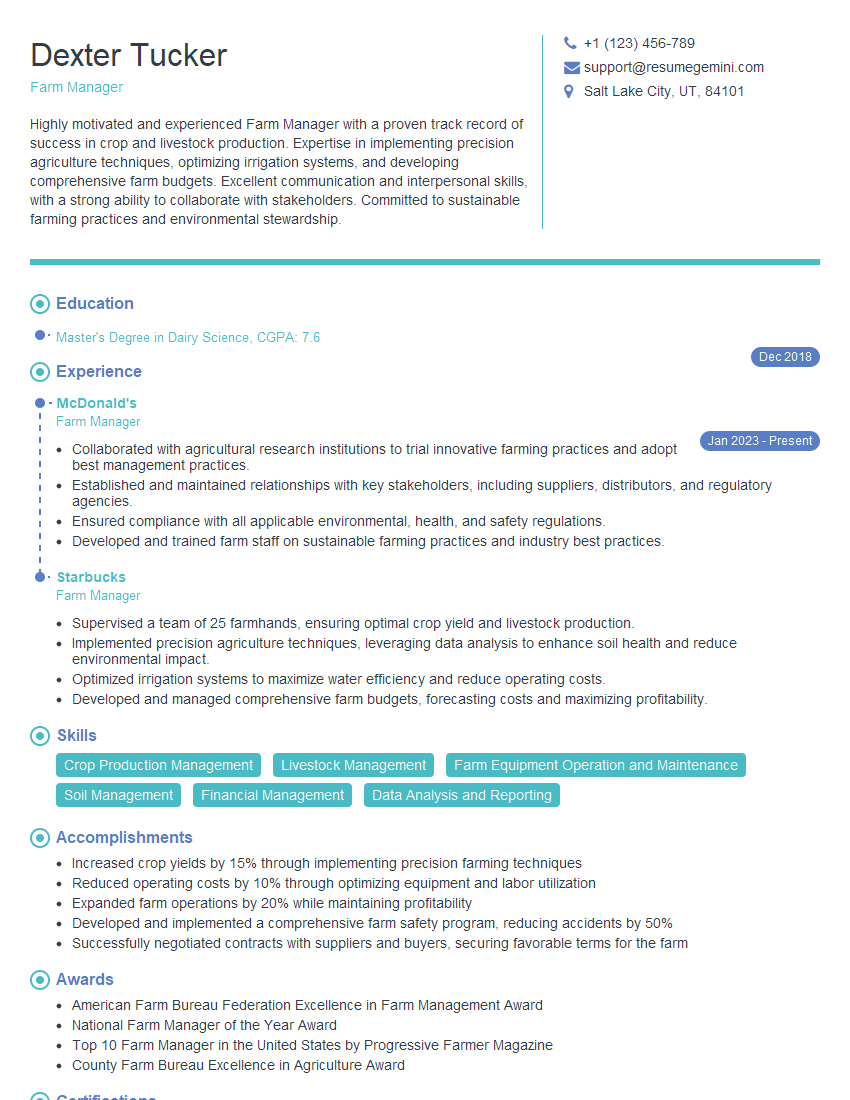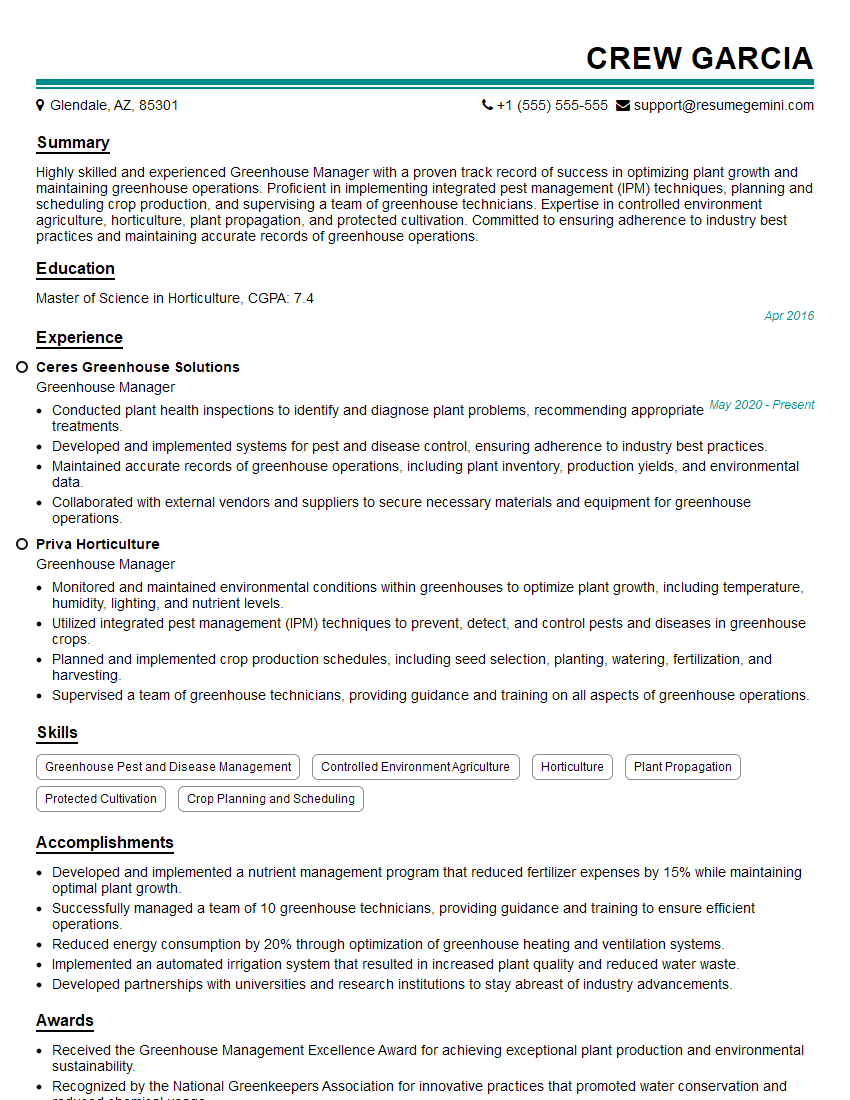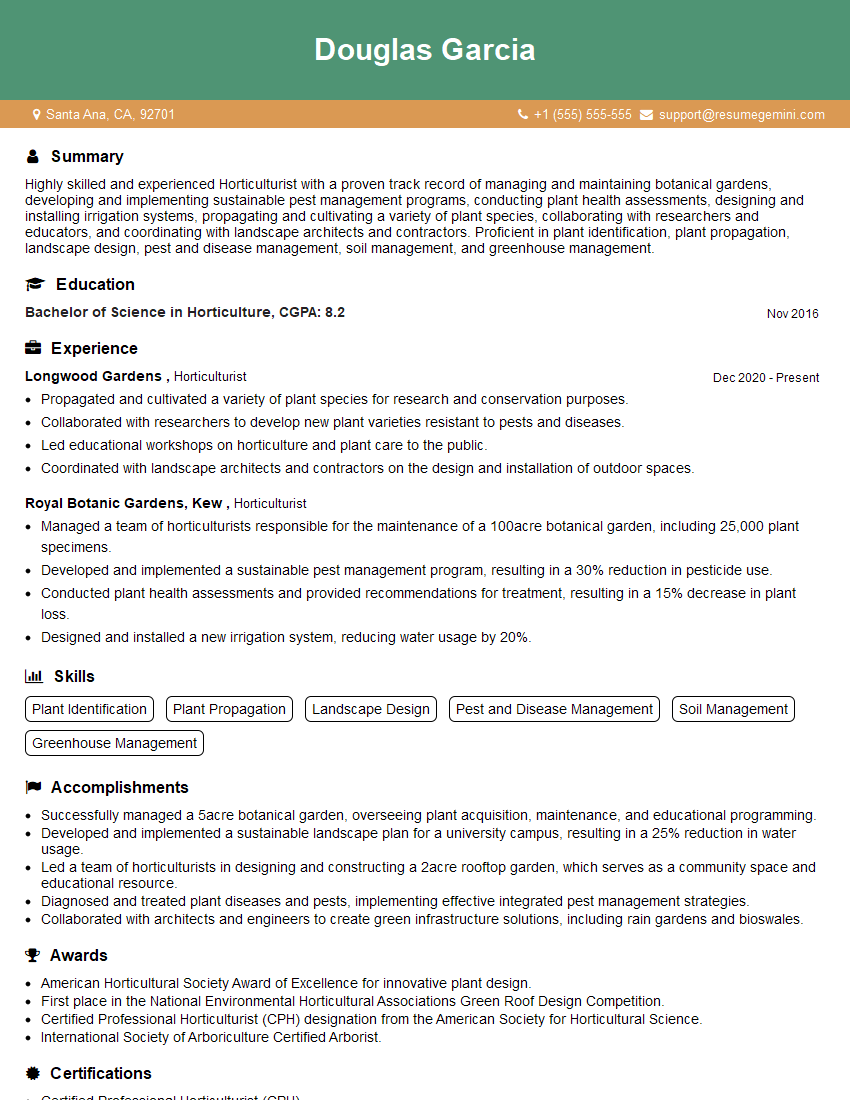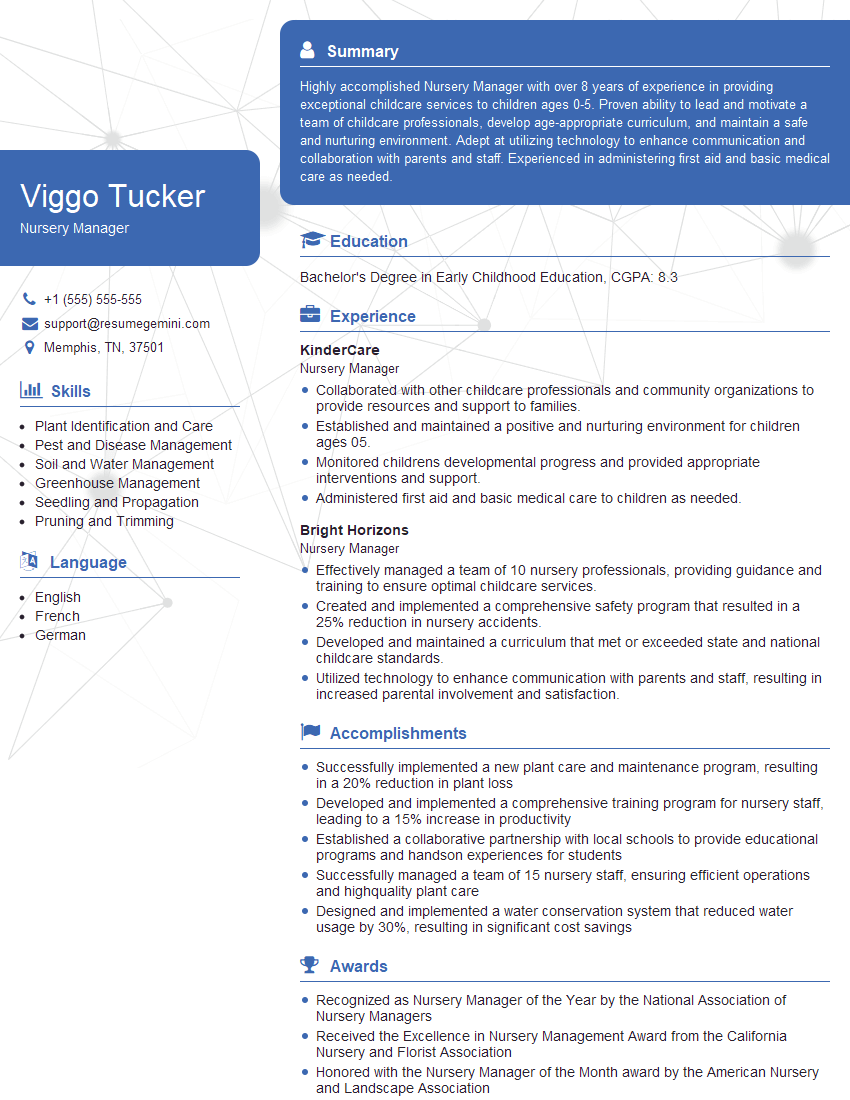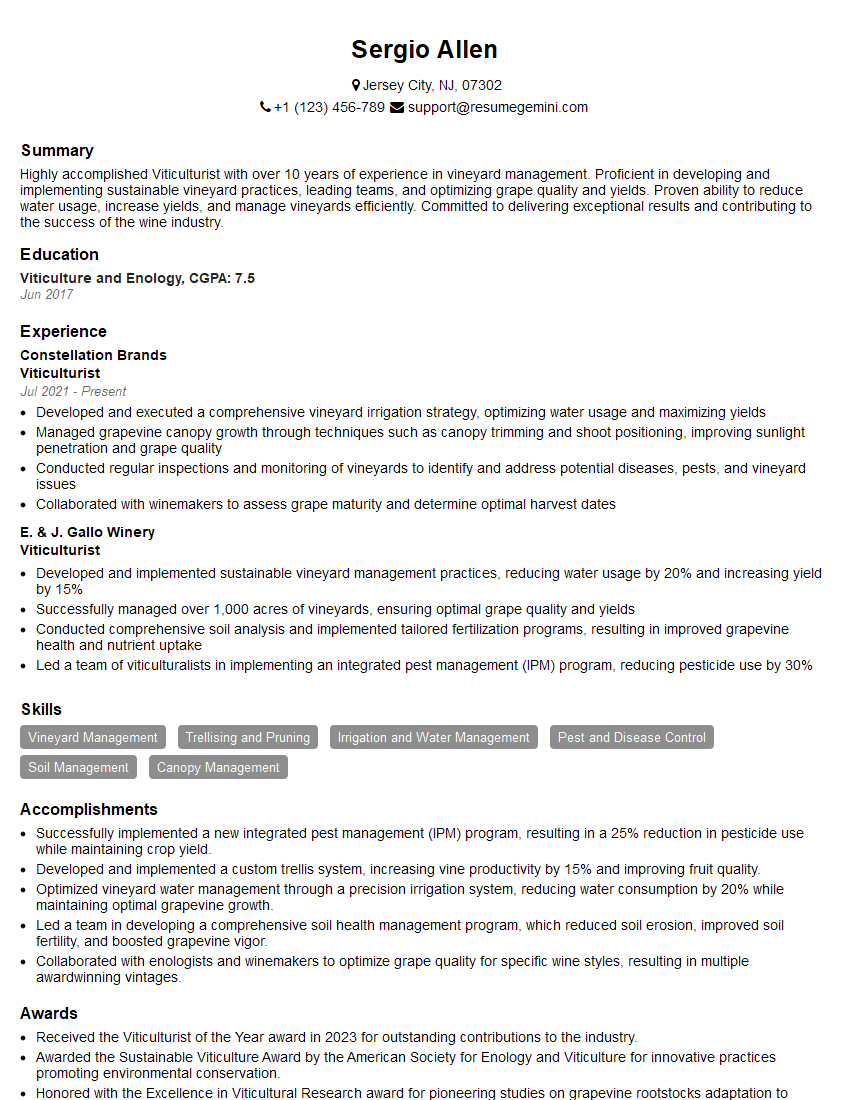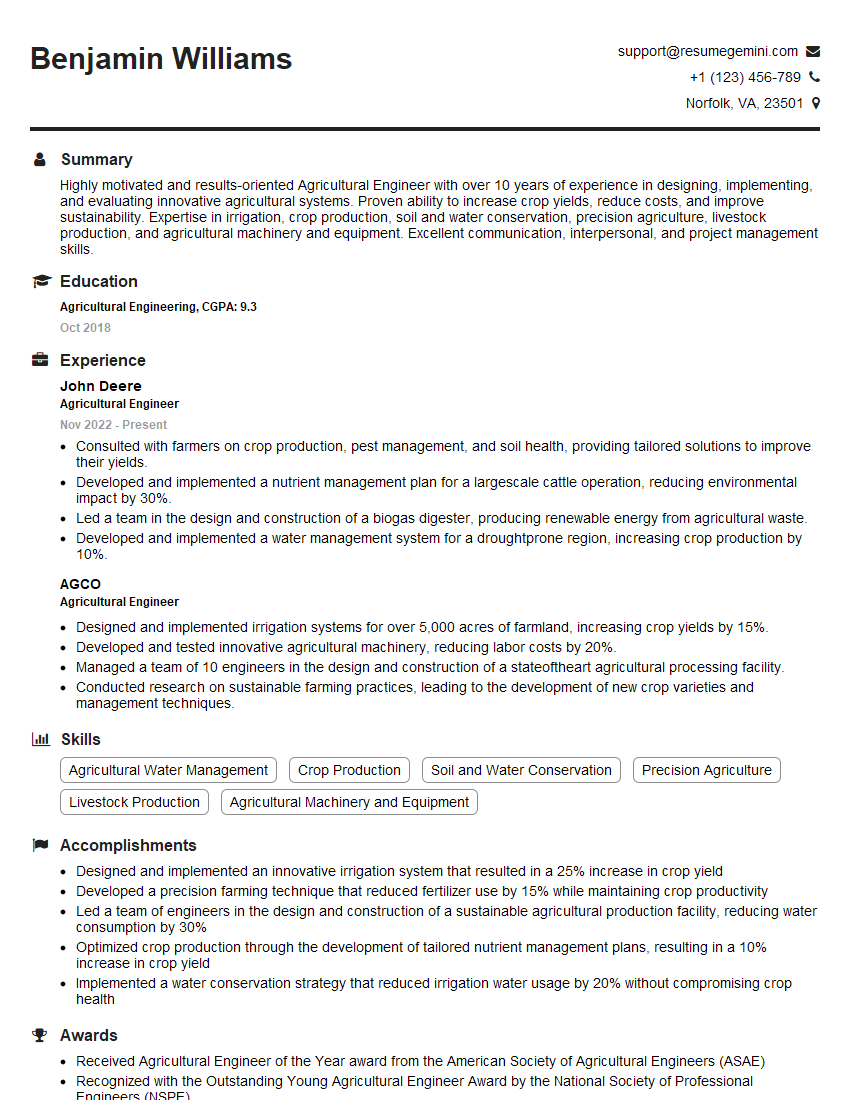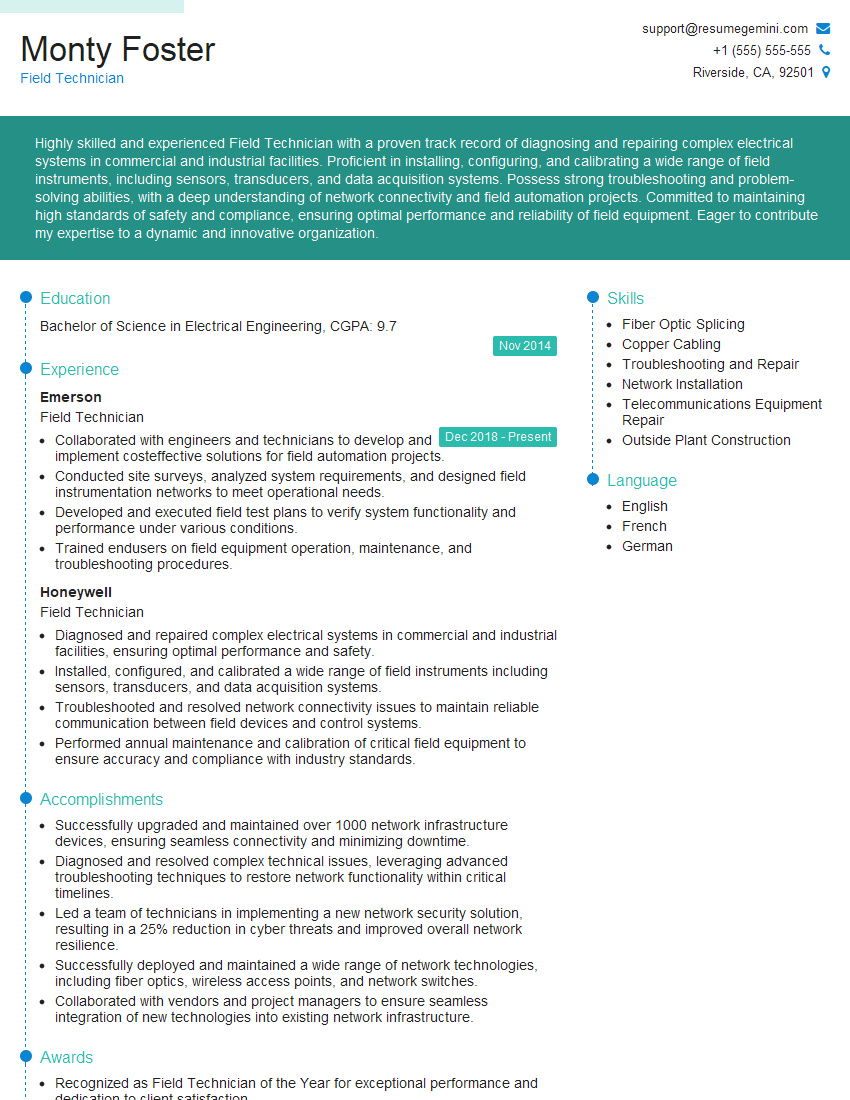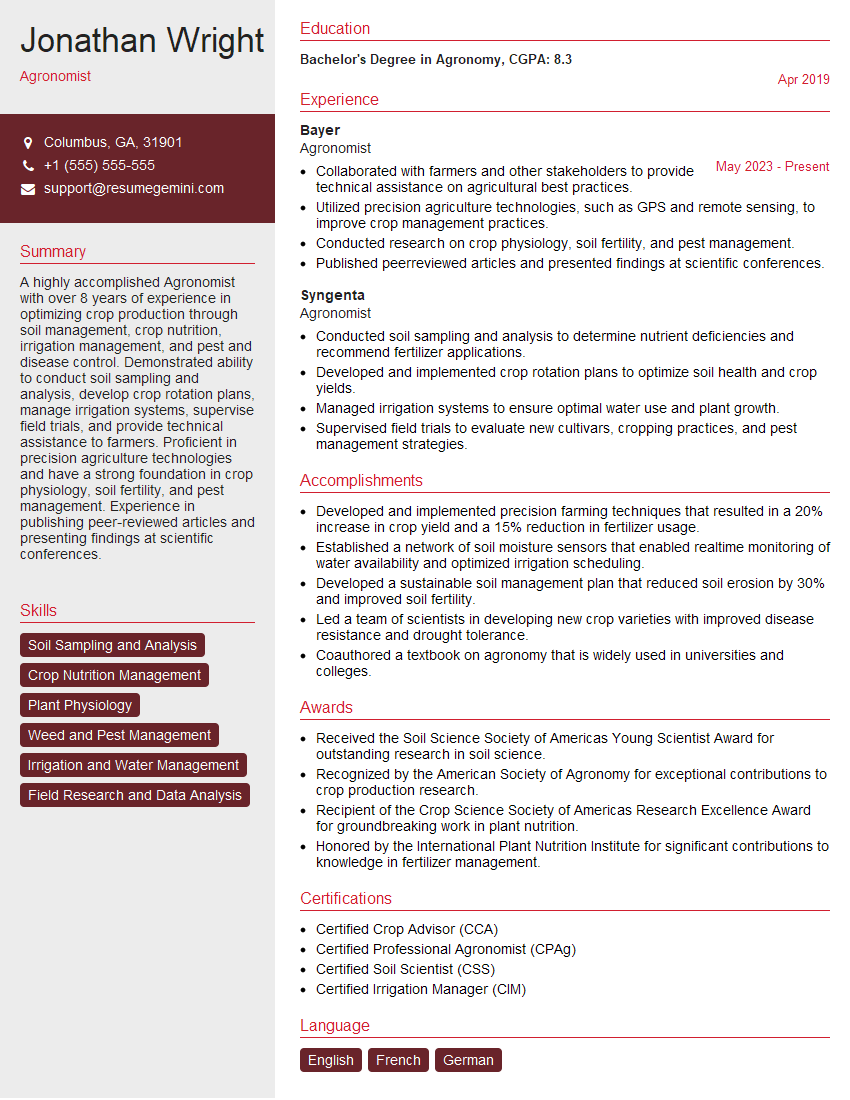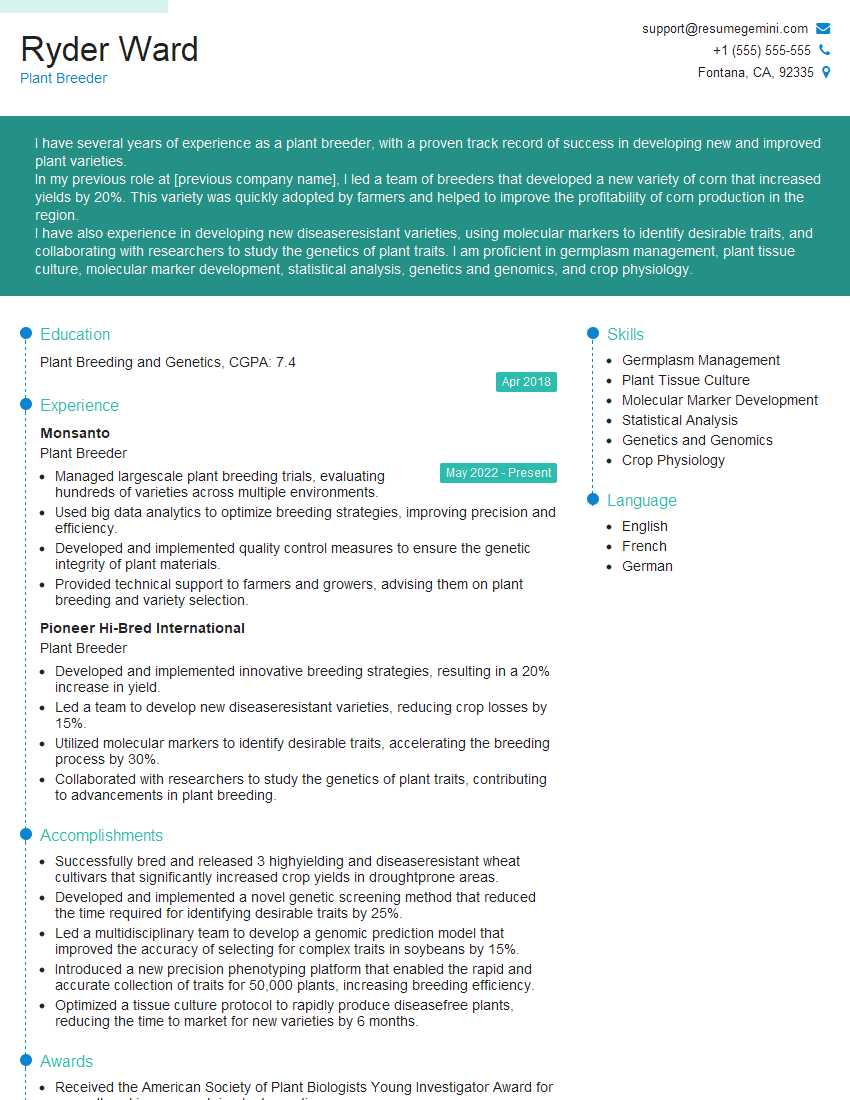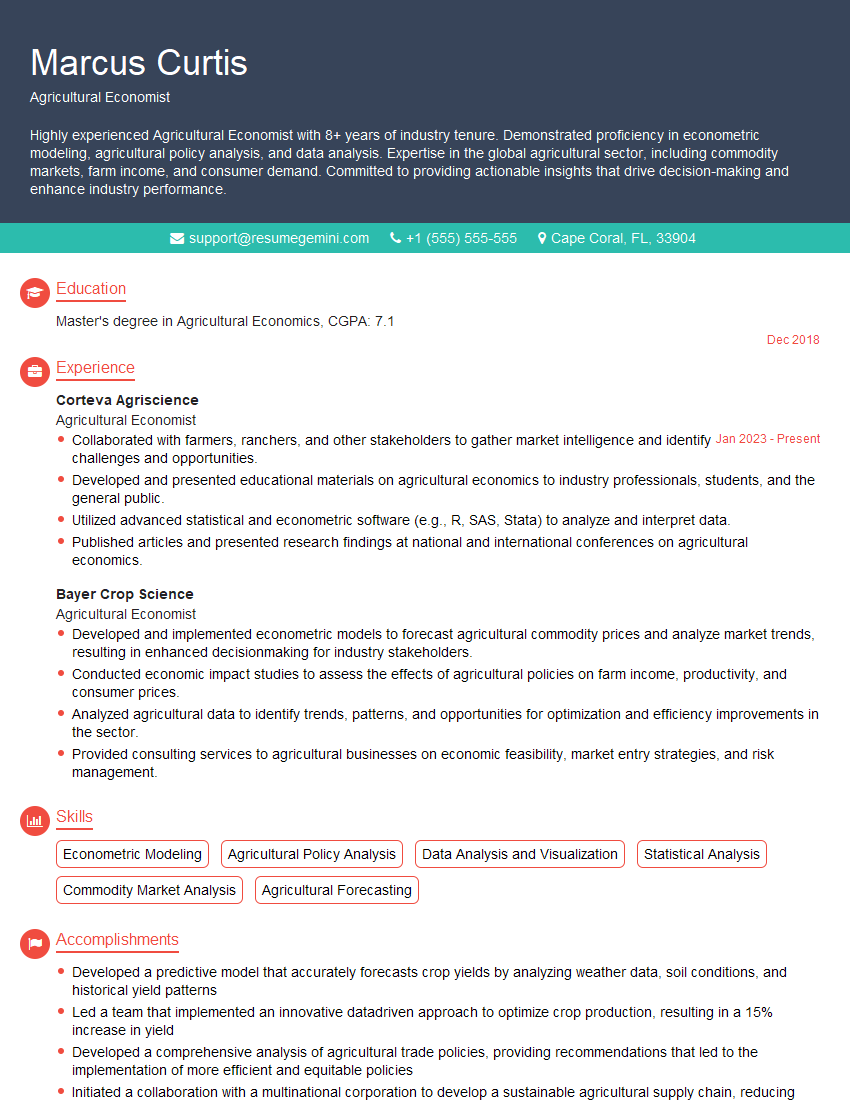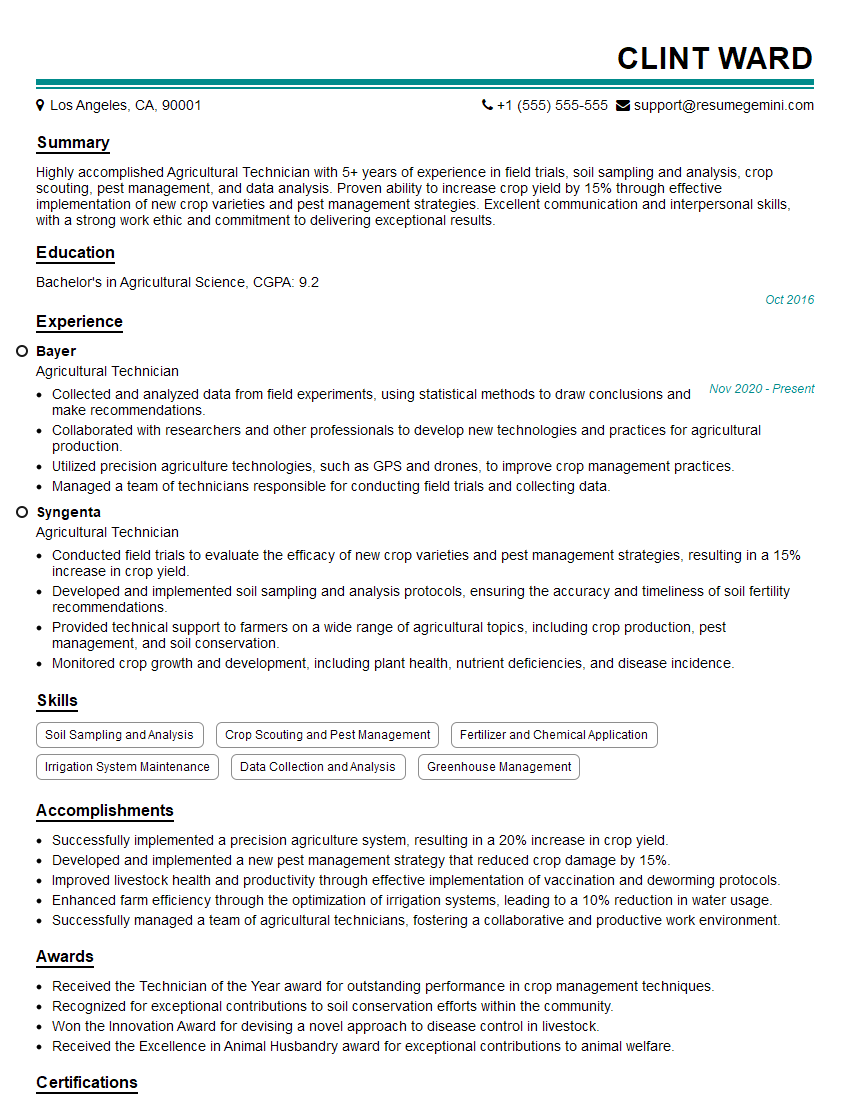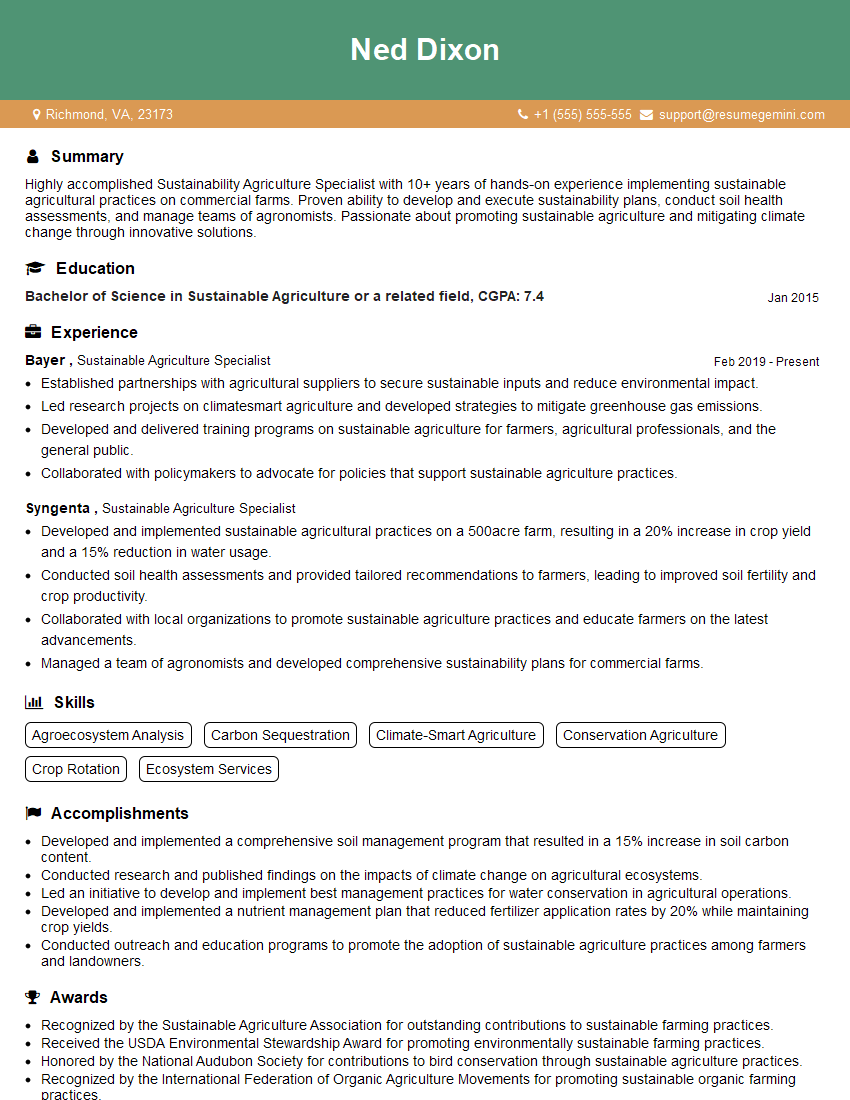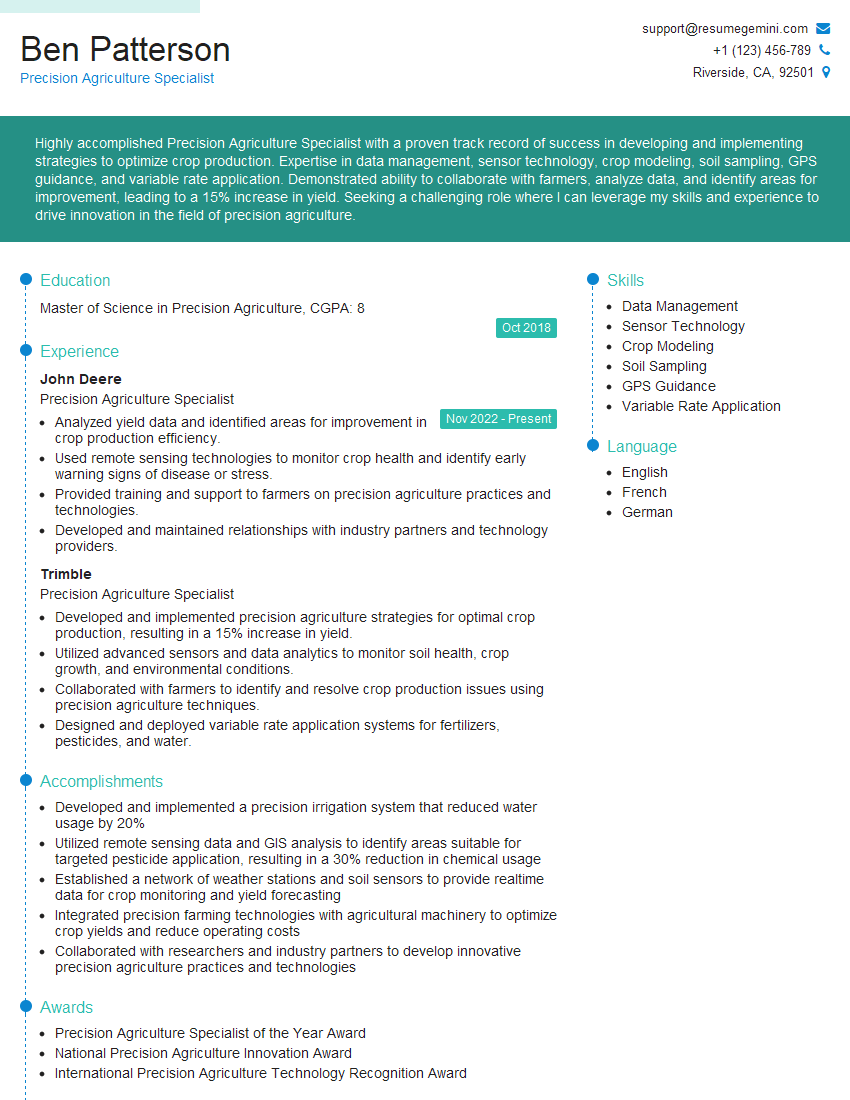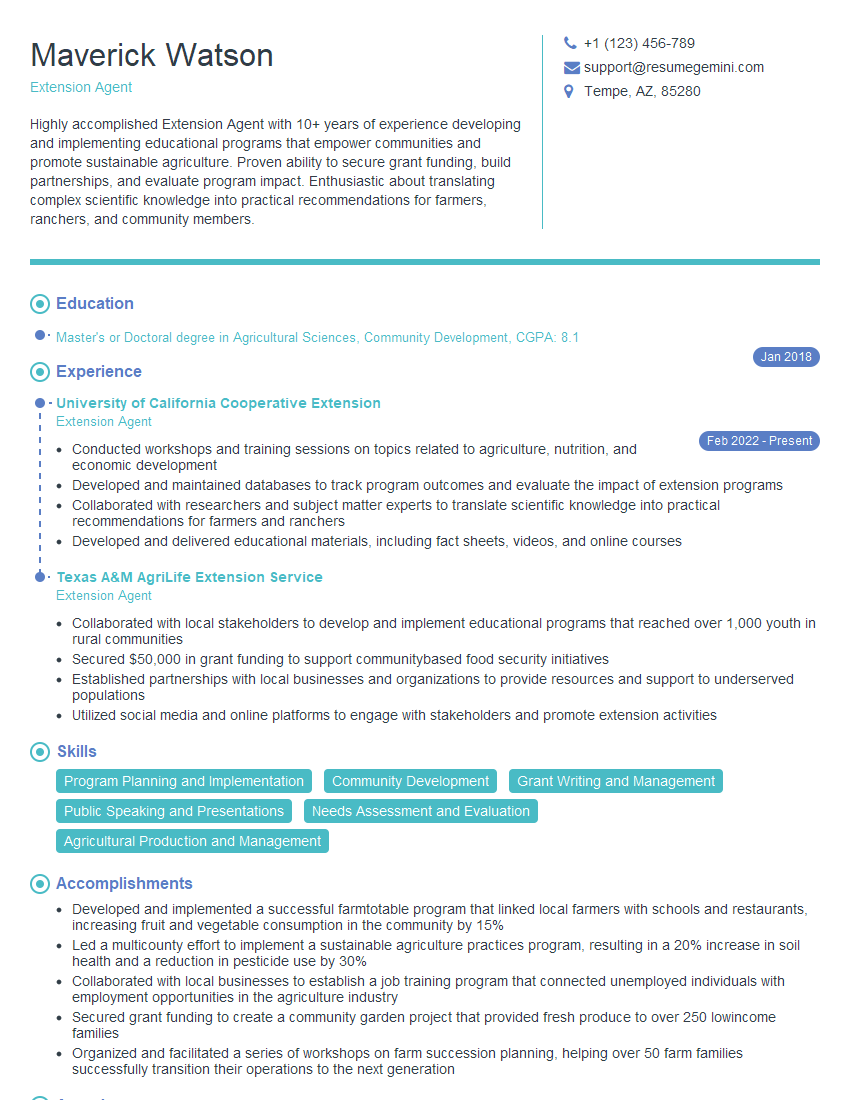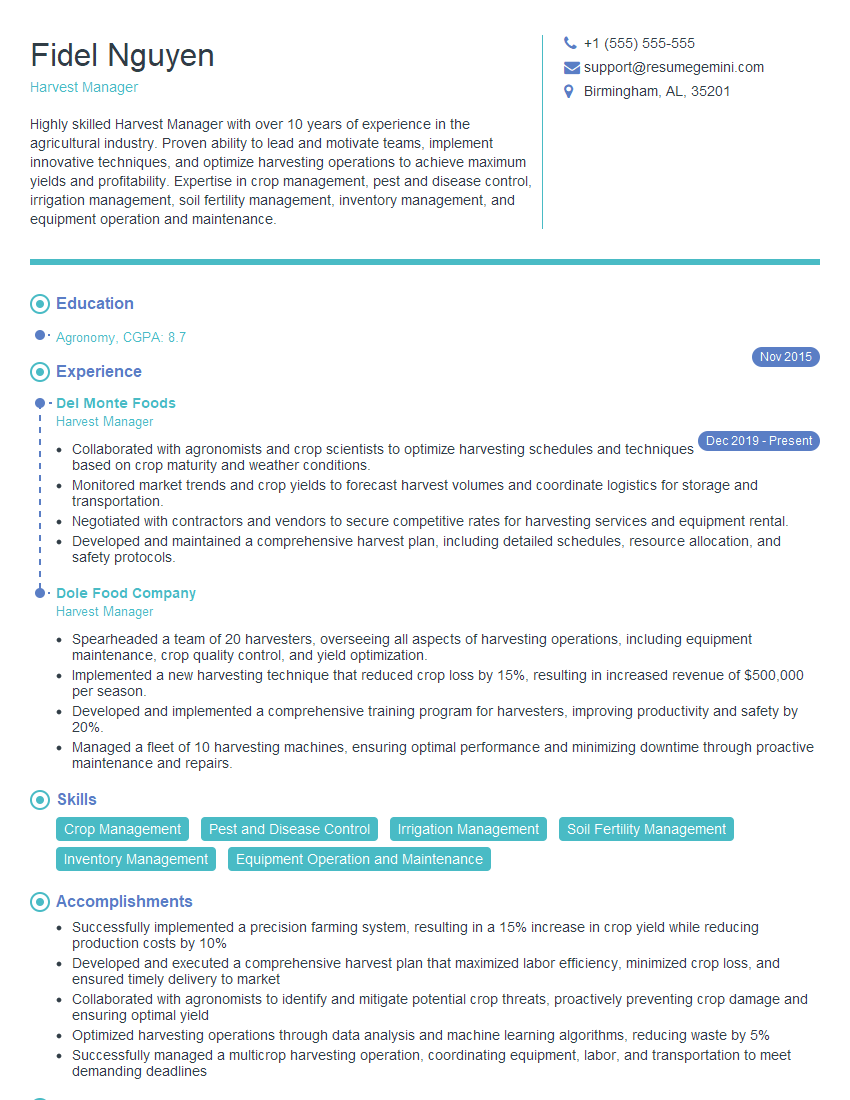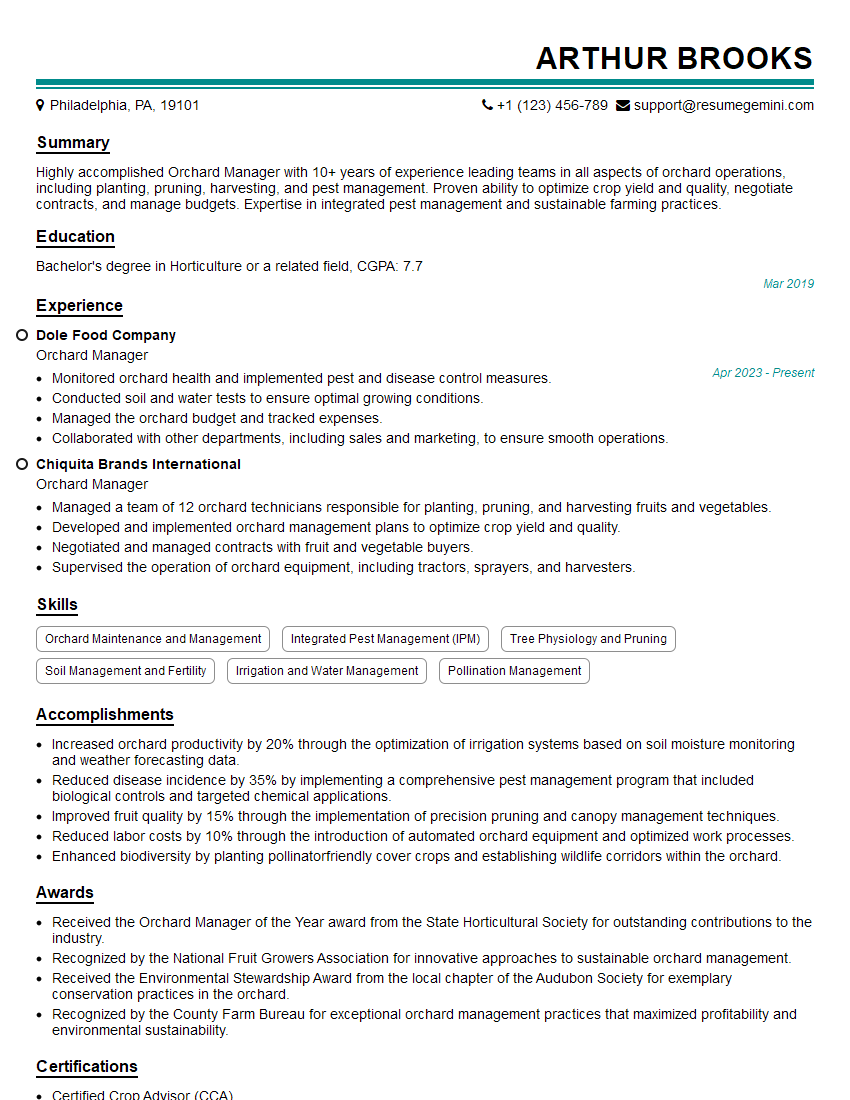Every successful interview starts with knowing what to expect. In this blog, we’ll take you through the top Crop Cultivation and Management interview questions, breaking them down with expert tips to help you deliver impactful answers. Step into your next interview fully prepared and ready to succeed.
Questions Asked in Crop Cultivation and Management Interview
Q 1. Describe the different methods of soil testing and their importance in crop cultivation.
Soil testing is crucial for understanding the nutritional status and physical properties of your soil, directly impacting crop health and yield. Several methods exist, each offering valuable insights.
Visual Inspection: This is the simplest method, observing soil color, texture, and drainage. While not precise, it offers a quick assessment of potential issues like compaction or waterlogging. For example, a dark brown soil generally indicates high organic matter content, while a light gray color might suggest poor drainage.
Simple Field Tests: These involve basic tests like checking pH using litmus paper or assessing nutrient levels through simple chemical reactions. While less accurate than lab tests, they provide a quick on-site evaluation and can identify major deficiencies. A low pH (acidic soil) might indicate a need for liming.
Laboratory Analysis: This is the most comprehensive method. Soil samples are sent to a laboratory for detailed analysis of pH, nutrient levels (nitrogen, phosphorus, potassium, etc.), organic matter content, salinity, and texture. Results offer precise recommendations for fertilizer application and soil amendment. For example, a lab report indicating low phosphorus levels would suggest the need for phosphorus-rich fertilizers.
The importance of soil testing cannot be overstated. It allows for precision agriculture, preventing over-fertilization (which can harm the environment and waste resources) and ensuring optimal nutrient supply for maximum crop yields. Regular soil testing, ideally annually or biennially, is key to maintaining soil health and improving crop productivity.
Q 2. Explain the principles of crop rotation and its benefits.
Crop rotation is the practice of planting different crops in a planned sequence on the same piece of land over several growing seasons. It’s like giving your soil a balanced diet and workout regime!
Principles: The core principle involves rotating crops with different nutrient needs and root systems. For instance, a legume (like beans or peas) which fixes nitrogen in the soil can be followed by a heavy feeder (like corn) that requires high nitrogen levels. This reduces the need for synthetic nitrogen fertilizers, saving costs and protecting the environment.
Nutrient Management: Different crops extract different nutrients from the soil. Rotation helps to balance nutrient depletion and improve soil fertility. Legumes, for example, enrich the soil with nitrogen.
Pest and Disease Control: Rotating crops disrupts the life cycles of pests and diseases specific to certain crops, reducing their populations and the need for pesticides.
Weed Control: Certain crop rotations can suppress weed growth, thereby reducing the reliance on herbicides.
Soil Improvement: Different root systems improve soil structure. Deep-rooted crops break up compacted soil, enhancing aeration and water infiltration.
Example: A three-year rotation might include corn (heavy nitrogen feeder), soybeans (nitrogen fixer), and wheat (moderate nutrient requirements). This cycle helps maintain soil health and minimizes the need for intensive inputs.
Q 3. What are the key factors to consider when selecting crop varieties?
Choosing the right crop variety is fundamental to successful cultivation. Key factors to consider include:
Climate and Soil Conditions: Select varieties adapted to your specific local climate (temperature, rainfall, sunlight) and soil type (texture, pH, drainage). For instance, a drought-tolerant variety is crucial in arid regions.
Disease and Pest Resistance: Choose varieties with resistance to prevalent diseases and pests in your area. This reduces reliance on pesticides and improves yields.
Maturity and Yield: Consider the desired growing season length and the expected yield. Early-maturing varieties are suitable for shorter growing seasons.
Market Demand: Select varieties that meet market demands in terms of quality, size, and other characteristics.
Quality Traits: Consider factors such as taste, nutritional value, storage ability, and processing characteristics, depending on the crop’s intended use.
For example, when choosing corn varieties, you might prioritize disease resistance to fungal infections like gray leaf spot prevalent in your region, and choose a variety with a high yield and suitable maturity for your growing season.
Q 4. How do you manage irrigation efficiently to optimize crop yields?
Efficient irrigation is crucial for optimizing crop yields while conserving water. Key strategies include:
Water Scheduling: Utilize soil moisture sensors or weather data to determine the optimal time and amount of irrigation, avoiding both overwatering and underwatering. Overwatering leads to root rot, while underwatering stunts growth.
Irrigation Method Selection: Choose the most appropriate irrigation method based on your crop, soil type, and water availability. Drip irrigation is highly efficient, delivering water directly to the roots, minimizing water loss through evaporation and runoff. Sprinkler systems are suitable for large fields but can be less efficient.
Improved Irrigation Infrastructure: Regularly maintain your irrigation system to prevent leaks and ensure uniform water distribution. Investing in pressure-regulating valves can ensure consistent water delivery.
Mulching: Applying mulch around plants helps retain soil moisture, reducing the frequency of irrigation. Mulch also suppresses weeds, further reducing water competition.
Water-Efficient Crop Varieties: Choosing drought-tolerant crop varieties can significantly reduce water requirements.
Careful monitoring of soil moisture and implementation of these techniques can ensure that crops receive the right amount of water at the right time, maximizing yield and minimizing water waste.
Q 5. Describe various pest and disease management strategies for a specific crop (e.g., corn).
Corn is susceptible to various pests and diseases. Effective management involves a multi-pronged approach.
Pest Management: Common corn pests include corn borers, aphids, and armyworms. Strategies include:
- Biological Control: Introducing natural predators like ladybugs (for aphids) or parasitic wasps (for borers).
- Crop Rotation: Rotating corn with non-host crops disrupts pest life cycles.
- Resistant Varieties: Planting pest-resistant corn hybrids reduces the need for insecticides.
- Insecticides (as a last resort): Use only when necessary and following label instructions carefully. Integrated Pest Management (IPM) principles are crucial here.
Disease Management: Common corn diseases include fungal diseases like gray leaf spot, southern leaf blight, and stalk rots. Strategies include:
- Resistant Varieties: Planting disease-resistant hybrids is the most effective strategy.
- Crop Rotation: Rotating with non-host crops reduces disease inoculum in the soil.
- Sanitation: Removing crop residues after harvest helps reduce disease carryover.
- Fungicides (as a last resort): Use only when necessary and following label instructions. Focus on preventative application rather than curative treatment.
Careful monitoring of pests and diseases through regular scouting is key to early detection and timely intervention. Preventive strategies are always preferred to minimize the need for chemical control.
Q 6. Explain the principles of integrated pest management (IPM).
Integrated Pest Management (IPM) is a sustainable approach to pest control that aims to minimize pesticide use while effectively managing pests. It’s about finding a balance – nature and technology working together.
Principles:
Monitoring: Regularly scout fields to monitor pest populations and identify potential problems early. This involves visual inspections and potentially using traps.
Economic Threshold: Determine the pest population level at which control measures are economically justified. Sometimes, a low pest population doesn’t warrant intervention.
Prevention: Implement practices to prevent pest problems before they occur. This includes crop rotation, resistant varieties, and sanitation.
Control Measures: Use a combination of methods, prioritizing least-toxic options. This might include biological control (introducing natural enemies), cultural control (crop rotation, sanitation), and chemical control (only as a last resort and used judiciously).
Evaluation: Regularly assess the effectiveness of your IPM program and adjust strategies as needed. Keeping records of pest populations, control measures, and crop yields is essential for ongoing improvement.
IPM is a holistic strategy that considers environmental impacts, economic viability, and the long-term sustainability of pest management. It’s not about eliminating pests entirely, but about keeping their populations below economically damaging levels.
Q 7. What are the common nutrient deficiencies in crops and how do you address them?
Nutrient deficiencies in crops lead to stunted growth, reduced yields, and poor quality. Common deficiencies include:
Nitrogen (N): Symptoms include pale green or yellow leaves, especially older ones, and stunted growth. Nitrogen is crucial for chlorophyll production and overall plant growth.
Phosphorus (P): Symptoms include dark green or purplish leaves, delayed maturity, and reduced root development. Phosphorus is vital for root growth, flowering, and fruit development.
Potassium (K): Symptoms include yellowing and browning of leaf margins, weak stalks, and reduced disease resistance. Potassium is important for water regulation, disease resistance, and overall plant strength.
Other Micronutrients: Deficiencies in micronutrients like iron, zinc, manganese, and boron can also occur, often resulting in specific leaf discoloration patterns or distorted growth. These are usually less common but equally important.
Addressing Deficiencies:
Soil Testing: Accurate diagnosis begins with a soil test, which helps identify the specific nutrient deficiency.
Fertilizer Application: Apply the appropriate fertilizer containing the missing nutrient. This can be done through broadcasting, banding, or foliar application (spraying on leaves).
Soil Amendments: Improve soil health through organic matter addition (compost, manure) to enhance nutrient availability and improve soil structure.
Crop Rotation: Including legumes in the rotation can naturally increase soil nitrogen.
It’s important to remember that over-fertilization can also be harmful. A soil test-guided approach ensures that crops receive the right amount of nutrients, optimizing yields and protecting the environment.
Q 8. How do you assess soil health and fertility?
Assessing soil health and fertility is crucial for successful crop cultivation. It involves a multi-faceted approach combining visual observation with laboratory analysis. We look at several key indicators:
- Visual Inspection: This includes observing soil color, texture, structure (presence of aggregates), and drainage. Darker colors often indicate higher organic matter content, while good structure suggests better aeration and water retention. Poor drainage can indicate compaction or clay dominance.
- Soil Texture Analysis: Determining the proportions of sand, silt, and clay is fundamental. This impacts water holding capacity, nutrient availability, and drainage. A simple “ribbon test” can give a quick field assessment, followed by laboratory analysis for precise quantification.
- Soil pH Testing: pH measures soil acidity or alkalinity and is critical as nutrient availability is heavily influenced by it. Optimal pH varies with the crop; most prefer a slightly acidic to neutral range (6.0-7.0). Testing kits are readily available for quick field assessments, while more precise laboratory tests provide detailed information.
- Nutrient Analysis: Laboratory analysis is essential to determine the levels of essential macronutrients (nitrogen, phosphorus, potassium) and micronutrients (e.g., iron, zinc, boron). This helps identify nutrient deficiencies and guide fertilizer recommendations. Soil samples should be collected strategically to represent the entire field accurately.
- Organic Matter Content: High organic matter improves soil structure, water retention, and nutrient availability. We often measure this through laboratory analysis, looking for indicators like loss on ignition (LOI).
- Biological Activity: Healthy soil teems with microbial life. Though difficult to quantify directly in the field, observing earthworm populations and the presence of other beneficial organisms is an indirect indicator of soil health.
By combining these assessments, we build a comprehensive picture of the soil’s condition, enabling us to tailor management practices to optimize crop production and environmental sustainability. For instance, if we find low organic matter and poor structure, we might incorporate cover crops or amend the soil with compost to improve its health.
Q 9. Explain the importance of cover crops in sustainable agriculture.
Cover crops are plants grown primarily for soil improvement rather than direct harvest. They play a vital role in sustainable agriculture by improving soil health and reducing reliance on synthetic inputs. Their benefits are numerous:
- Improved Soil Structure: Cover crops with extensive root systems help break up compacted soil, improving aeration and water infiltration. For example, rye is excellent for this purpose.
- Increased Organic Matter: When cover crops decompose, they add organic matter to the soil, enhancing its fertility and water-holding capacity. Legumes, such as clover or vetch, are particularly beneficial because they fix nitrogen from the atmosphere.
- Weed Suppression: A dense cover crop canopy can effectively suppress weed growth, reducing the need for herbicides.
- Erosion Control: Cover crops provide a protective layer on the soil surface, preventing erosion caused by wind and water. This is crucial in sloping areas or during periods of heavy rainfall.
- Nutrient Cycling: Cover crops can scavenge excess nutrients left in the soil after the main crop harvest, preventing nutrient runoff and making those nutrients available for the subsequent crop.
- Pest and Disease Management: Some cover crops can suppress certain pests and diseases, reducing the need for pesticides. For example, certain brassicas can suppress nematodes.
In a practical setting, farmers might choose a mix of cover crops based on their specific needs and soil conditions. For instance, a mix of legumes and grasses can provide both nitrogen fixation and improved soil structure. The selection process also considers factors like climate, the length of the growing season, and the subsequent main crop.
Q 10. Discuss the impact of climate change on crop production.
Climate change poses significant challenges to crop production worldwide. Changes in temperature, precipitation patterns, and the frequency of extreme weather events directly impact crop yields and quality.
- Increased Temperatures: Higher temperatures can accelerate crop development, leading to reduced yields, particularly in heat-sensitive crops. It can also lead to increased evapotranspiration, requiring more irrigation.
- Altered Precipitation Patterns: Changes in rainfall patterns, including increased frequency of droughts or floods, can disrupt planting schedules, affect soil moisture, and damage crops. Water stress is a major concern in many regions.
- Extreme Weather Events: Increased frequency and intensity of heat waves, droughts, floods, and storms cause significant damage to crops, resulting in yield losses and economic hardship for farmers.
- Pest and Disease Outbreaks: Warmer temperatures and changes in humidity can favor the spread of pests and diseases, reducing crop yields and quality.
- Changes in Growing Season Length: Changes in the length and timing of growing seasons can impact the suitability of certain crops in specific regions, necessitating shifts in crop selection and planting practices.
Adaptation strategies are crucial to mitigate these impacts. This might include selecting drought-tolerant or heat-tolerant crop varieties, improving irrigation efficiency, adopting climate-smart agricultural practices (e.g., conservation tillage), and diversifying cropping systems to reduce risk.
Q 11. Describe different methods of weed control.
Weed control is essential for maximizing crop yields and quality. Various methods can be employed, often in an integrated approach:
- Cultural Control: This involves using agricultural practices to suppress weeds. Examples include crop rotation (alternating crops to disrupt weed life cycles), proper tillage (to bury weed seeds), and mulching (to prevent weed germination).
- Mechanical Control: This involves physically removing weeds. Methods include hand weeding, hoeing, mowing, and using cultivators. While labor-intensive, it’s environmentally friendly and avoids chemical residues.
- Biological Control: This uses natural enemies of weeds, such as insects, fungi, or other plants, to control weed populations. This is a more sustainable approach but requires careful selection and management to avoid unintended ecological consequences.
- Chemical Control (Herbicides): Herbicides are chemical substances used to kill weeds. They are effective but can have negative environmental impacts if not used judiciously. Integrated pest management (IPM) strategies aim to minimize herbicide use and incorporate other control methods to reduce environmental risks.
The choice of weed control method depends on several factors, including the type of weed, the crop, the soil type, and environmental concerns. Often, a combination of methods is the most effective and sustainable approach. For example, a farmer might use cover crops to suppress weeds initially, followed by mechanical weeding as needed and only resort to herbicides as a last resort for particularly problematic weeds.
Q 12. How do you monitor crop growth and development?
Monitoring crop growth and development is crucial for making timely management decisions. We utilize various methods:
- Visual Observation: Regular field visits to assess plant height, color, vigor, and signs of stress (e.g., wilting, discoloration) are essential. This gives an overall impression of crop health and identifies potential problems early on.
- Growth Staging: Tracking the developmental stages of the crop (e.g., vegetative growth, flowering, fruiting) allows for precise timing of irrigation, fertilization, and pest control. This often involves using standardized growth scales specific to the crop.
- Remote Sensing: Techniques such as satellite imagery or drone-based imagery can provide information on large areas, including canopy cover, vegetation indices (NDVI), and crop stress. This helps identify areas with variability in growth or stress, guiding targeted interventions.
- Ground-Based Sensors: Various sensors can measure soil moisture, temperature, and nutrient levels. This allows for precise monitoring and management of environmental factors affecting crop growth.
- Data Logging and Analysis: Recording all observations and sensor data allows for tracking of crop growth over time, identifying trends, and evaluating the effectiveness of management practices. This often involves using specialized software for data analysis and visualization.
For example, a farmer might notice stunted growth in a specific area of the field during a visual inspection. This could then prompt a closer investigation using soil sensors to determine if the cause is water stress or nutrient deficiency. Adjustments in irrigation or fertilization can then be made to address the problem promptly.
Q 13. Explain the principles of precision agriculture.
Precision agriculture involves using technology and data to manage crops with site-specific precision, optimizing resource use and maximizing efficiency. Key principles include:
- Site-Specific Management: Recognizing that fields are not uniform and that conditions vary spatially. This means tailoring management practices (e.g., fertilizer application, irrigation, pest control) to specific areas within the field based on their individual needs.
- Data Acquisition: Collecting data on various factors influencing crop growth, such as soil properties, yield maps, weather data, and sensor readings. This data forms the basis for informed decision-making.
- Information Technology: Using software and hardware to process and analyze data, create maps, and guide management decisions. Geographic Information Systems (GIS) are commonly used for this purpose.
- Variable Rate Technology: Adjusting the application rate of inputs (e.g., fertilizer, pesticides, seeds) according to the specific needs of different areas within the field. This optimizes resource use and minimizes environmental impact.
- Feedback Loops: Continuously monitoring and evaluating the effects of management decisions, using the data to refine future practices. This iterative approach aims to continuously improve efficiency and sustainability.
For instance, using yield maps from previous harvests, a farmer can identify areas with lower yields. Soil samples can then be taken from these areas to determine if nutrient deficiencies are the cause. Variable rate fertilization can then be applied to address this deficiency in the subsequent growing season, resulting in improved yields in the low-yielding areas.
Q 14. What are the benefits and challenges of using genetically modified crops?
Genetically modified (GM) crops have both benefits and challenges:
- Benefits:
- Increased Yield: GM crops can have higher yields than their conventional counterparts, contributing to food security.
- Improved Pest and Disease Resistance: GM crops engineered to resist specific pests or diseases reduce the need for pesticides, minimizing environmental impact and reducing production costs.
- Enhanced Herbicide Tolerance: Herbicide-tolerant GM crops allow farmers to use broader-spectrum herbicides, simplifying weed management.
- Improved Nutritional Value: GM crops can be engineered to have enhanced nutritional content, contributing to improved human health.
- Challenges:
- Potential Environmental Risks: Concerns exist regarding the potential impact of GM crops on biodiversity, the development of herbicide-resistant weeds, and the potential for gene flow to wild relatives.
- Economic Concerns: The high cost of developing and patenting GM crops can create barriers to entry for smallholder farmers.
- Social and Ethical Concerns: There are debates about the ethical implications of genetic modification and the potential for corporate control over the food supply.
- Consumer Acceptance: Consumer acceptance of GM foods varies widely depending on cultural and social factors.
Careful regulation and responsible development are crucial to address these challenges and maximize the benefits of GM crops. Research into the long-term environmental and health impacts is ongoing, and transparent communication with consumers is essential to build trust and address concerns.
Q 15. Discuss your experience with data analysis related to crop yields.
Data analysis is crucial for optimizing crop yields. My experience involves using various tools and techniques to analyze data from various sources, including yield monitors on harvesting equipment, soil sensors, weather stations, and farm management software. This data allows me to identify trends and patterns affecting crop performance.
For instance, I once analyzed yield data from a corn field across multiple years, correlating it with rainfall data and nitrogen application rates. This revealed that while higher nitrogen application initially increased yields, beyond a certain point, it led to diminishing returns and even yield reduction in years with lower rainfall. This informed future fertilizer management strategies, resulting in a 15% increase in average yield over the next three years.
I also utilize statistical modeling techniques like regression analysis to predict yield based on various factors. This predictive capability helps in proactive decision-making, such as adjusting irrigation schedules or applying pest control measures based on predicted yield impacts. Furthermore, I employ Geographic Information Systems (GIS) to visualize spatial variations in yield across fields, allowing for site-specific management practices.
Career Expert Tips:
- Ace those interviews! Prepare effectively by reviewing the Top 50 Most Common Interview Questions on ResumeGemini.
- Navigate your job search with confidence! Explore a wide range of Career Tips on ResumeGemini. Learn about common challenges and recommendations to overcome them.
- Craft the perfect resume! Master the Art of Resume Writing with ResumeGemini’s guide. Showcase your unique qualifications and achievements effectively.
- Don’t miss out on holiday savings! Build your dream resume with ResumeGemini’s ATS optimized templates.
Q 16. How do you manage harvest operations to minimize losses?
Minimizing harvest losses requires a multi-pronged approach focusing on pre-harvest planning, efficient harvesting techniques, and careful post-harvest handling. Pre-harvest planning includes selecting appropriate maturity stages for harvest, scouting for potential problems like lodging (plants falling over), and ensuring equipment is properly calibrated and maintained.
During harvest, timely harvesting is vital to avoid losses due to weather damage, diseases, or over-ripening. Proper equipment operation and speed are crucial. For example, setting the combine header height correctly minimizes losses from crop scattering or header clogging. Regular monitoring of the combine’s performance indicators, such as grain loss sensors, helps to make real-time adjustments. Finally, careful handling of harvested produce during transportation to storage facilities minimizes damage.
A practical example involved implementing a new strategy for harvesting wheat. By adjusting the combine settings based on real-time data from yield monitors and loss sensors, we reduced the overall harvest losses by 8%, saving significant amounts of money and improving overall efficiency.
Q 17. Explain post-harvest handling and storage techniques for a specific crop.
Let’s consider post-harvest handling and storage of potatoes. Proper handling starts immediately after harvest. Potatoes should be gently handled to avoid bruising, which reduces their shelf life and market value. Cleaning and grading are crucial steps to remove soil, debris, and damaged tubers. Grading involves sorting potatoes based on size and quality for various market demands.
Storage conditions are critical for maintaining potato quality. Potatoes should be stored in a cool, dark, and well-ventilated environment with high humidity (around 90-95%) to prevent sprouting and dehydration. Temperature should be maintained between 2°C and 4°C (35°F and 39°F). Regular monitoring of temperature and humidity levels is crucial to prevent spoilage and maintain optimal storage conditions.
In a real-world scenario, implementing a controlled atmosphere storage (CAS) system for potatoes significantly extended their shelf life. CAS involves manipulating the atmospheric composition within the storage facility to reduce respiration rate and delay sprouting, extending the storage period by several months compared to conventional storage methods and reducing waste.
Q 18. Describe your experience with various tillage methods.
My experience encompasses various tillage methods, including conventional tillage, conservation tillage (no-till, reduced tillage), and strip-till. Conventional tillage, involving deep plowing and harrowing, provides excellent weed control and soil aeration but can lead to soil erosion and loss of soil organic matter. Conservation tillage methods minimize soil disturbance, improving soil health and reducing erosion.
No-till farming involves planting directly into the previous year’s residue, eliminating the need for plowing. Reduced tillage involves minimal soil disturbance, often using techniques like chisel plowing or vertical tillage. Strip-till involves tilling only narrow strips where the crop will be planted, leaving the rest of the soil undisturbed. The choice of method depends on factors such as soil type, crop type, climate, and farming goals.
For example, I transitioned a farm from conventional tillage to no-till for corn production. This led to improved soil structure, higher water infiltration rates, reduced erosion, and ultimately, a more sustainable farming system, even though the initial yield might have been slightly lower in the transition period.
Q 19. What are the key considerations for selecting appropriate farm machinery?
Selecting appropriate farm machinery involves careful consideration of several factors. First, the type of crop being grown significantly influences machinery needs. A grain farm will require different equipment than a vegetable farm. Second, farm size and topography influence machinery choices. A large, flat field can accommodate larger equipment, while smaller, hilly fields may necessitate smaller, more maneuverable machines.
Third, the budget plays a crucial role. New equipment is expensive, while used equipment may require more maintenance. Fourth, the level of automation and technological features should be considered. Precision farming technologies, such as GPS-guided tractors and variable-rate applicators, enhance efficiency and optimize resource use. Finally, maintenance and repair capabilities should be evaluated, as reliable service is crucial for minimizing downtime.
For example, when upgrading a farm’s harvesting equipment, I conducted a thorough cost-benefit analysis comparing new and used combines, considering factors like purchase price, maintenance costs, fuel efficiency, and potential yield increases from improved harvesting technology. The analysis guided the selection of a used combine with modern upgrades which balanced cost-effectiveness and performance.
Q 20. How do you manage labor effectively during peak seasons?
Effective labor management during peak seasons requires careful planning and coordination. This includes accurate forecasting of labor needs based on the crop calendar, planting schedules, and harvesting timelines. Adequate recruitment and training of seasonal workers are essential. Clear communication channels must be established to ensure efficient task assignments and coordination among workers.
Incentive programs, such as performance-based pay or bonuses, can motivate workers and improve productivity. Providing necessary equipment, safety training, and comfortable working conditions also contributes to worker satisfaction and retention. Proper scheduling ensures enough workers are available during critical periods without overstaffing during less demanding times. Technology can help in labor management – using mobile apps or GPS-enabled devices for tracking work progress and worker location improves efficiency.
I employed a system of task-based teams for harvesting, where each team was responsible for a specific aspect of the process. This division of labor, along with careful scheduling using a field-based workflow management software, allowed us to harvest our crop significantly faster and with fewer labor-related issues, resulting in reduced harvesting costs and minimized crop loss.
Q 21. Describe your experience with farm budgeting and financial management.
Farm budgeting and financial management are critical for the farm’s success. This involves developing detailed budgets that project income and expenses for a specific period. Income projections are based on anticipated yields, market prices, and potential government subsidies. Expense projections include seeds, fertilizers, pesticides, machinery maintenance, labor costs, and debt repayment.
Regular financial monitoring involves tracking actual income and expenses against the budget, allowing for timely adjustments. Cash flow management is crucial, ensuring sufficient funds for timely payments. Understanding farm profitability requires analysis of key financial ratios, such as net income, return on investment, and debt-to-equity ratio. Seeking professional advice from agricultural economists or financial consultants can be invaluable for financial planning and decision-making.
In one case, using detailed budgeting and financial tracking, I identified an underperforming area within the farm’s operations, leading to strategic adjustments such as diversification of crops and implementation of cost-saving measures. These adjustments resulted in a significant improvement in overall farm profitability over a two-year period, showing the direct link between meticulous financial management and successful farm operations.
Q 22. Explain the importance of record-keeping in crop production.
Record-keeping is the backbone of successful crop production. It’s not just about jotting down numbers; it’s about building a comprehensive history of your farm’s performance, allowing for informed decision-making and continuous improvement. Think of it as a detailed diary of your crops’ lives, from planting to harvest.
Tracking Input Costs: Meticulously recording expenses like seeds, fertilizers, pesticides, labor, and irrigation helps in calculating the precise cost of production, essential for pricing strategies and profitability analysis. For example, knowing the exact amount of fertilizer used per acre allows for optimization in future seasons.
Monitoring Crop Yields: Regularly documenting yields – tons per hectare, bushels per acre, etc. – allows you to track progress, identify trends, and compare the effectiveness of different cultivation techniques. A farmer might discover that a certain planting density consistently produces higher yields.
Pest and Disease Management: Recording the incidence and severity of pests and diseases helps predict outbreaks and informs preventative strategies. For instance, a detailed log of aphid infestations might reveal a correlation with specific weather patterns, aiding in future mitigation.
Soil Health Analysis: Tracking soil tests, including pH levels, nutrient content, and organic matter, is crucial for maintaining soil fertility and tailoring fertilization practices. This prevents nutrient deficiencies and reduces reliance on synthetic inputs.
Market Analysis: Keeping records of market prices, supply and demand, and consumer preferences helps in strategic planning and ensures that crops are harvested and sold at optimal times.
In essence, thorough record-keeping empowers data-driven decision making, leading to higher efficiency, profitability, and sustainable farming practices.
Q 23. How do you ensure food safety and quality in your operations?
Ensuring food safety and quality is paramount. It requires a holistic approach, starting from the selection of seeds and extending to post-harvest handling. We implement rigorous Good Agricultural Practices (GAPs) at every stage.
Seed Selection: We source certified disease-free seeds from reputable suppliers to minimize the risk of contamination.
Pest and Disease Management: We prioritize Integrated Pest Management (IPM) strategies, minimizing pesticide use and opting for biological controls whenever feasible. This protects both the environment and consumers.
Fertilizer Management: We utilize soil testing to determine precise fertilizer needs, avoiding excessive application and preventing nutrient runoff that can contaminate water sources.
Harvesting and Handling: We implement strict hygiene protocols during harvesting and post-harvest handling to prevent contamination. This includes proper cleaning and sanitation of equipment, and careful handling to minimize damage.
Storage and Transportation: We use appropriate storage facilities to maintain optimal temperature and humidity levels, preventing spoilage and minimizing microbial growth. Transportation methods are carefully chosen to preserve product quality.
Traceability: We maintain detailed traceability records, allowing us to track the origin and handling of every batch of produce, crucial for prompt identification and management of any food safety issues.
Regular internal audits and external certifications further strengthen our commitment to food safety and quality.
Q 24. Discuss your understanding of various agricultural certifications and standards.
Various certifications and standards ensure the quality, safety, and sustainability of agricultural products. They provide consumers and buyers with confidence and transparency.
Global GAP (Good Agricultural Practices): This widely recognized standard ensures safe and sustainable agricultural practices, addressing aspects like hygiene, traceability, and environmental protection.
Organic Certification: This certification signifies that crops have been grown without synthetic pesticides, herbicides, or fertilizers, appealing to consumers seeking environmentally friendly and healthy products.
Fairtrade Certification: This focuses on fair prices for producers and equitable labor practices, promoting social responsibility within the supply chain.
BRCGS (British Retail Consortium Global Standards): This standard provides a framework for food safety management systems, helping businesses demonstrate their commitment to producing safe and high-quality food.
ISO 22000: This is a food safety management system standard that outlines requirements for establishing, implementing, maintaining, and improving a food safety management system.
Understanding and adhering to these standards is crucial for accessing specific markets and building consumer trust. The choice of certification depends on the specific needs of the farm and the target market.
Q 25. Describe your experience with sustainable agriculture practices.
Sustainable agriculture is not just a trend; it’s a necessity for the long-term health of our planet and the viability of farming. My experience involves several key practices:
Crop Rotation: We rotate crops to improve soil health, reduce pest and disease pressure, and optimize nutrient cycling. For example, rotating legumes with cereal crops replenishes soil nitrogen.
Cover Cropping: Planting cover crops during fallow periods prevents soil erosion, improves soil structure, and suppresses weeds. Rye and clover are excellent cover crop options.
Integrated Pest Management (IPM): We utilize a combination of biological controls, cultural practices, and targeted pesticide applications only when necessary, minimizing environmental impact.
Water Conservation: We employ efficient irrigation techniques such as drip irrigation to minimize water waste and optimize water use efficiency.
Reduced Tillage: We minimize soil disturbance through reduced or no-till farming, preserving soil structure and organic matter.
Biodiversity Enhancement: We encourage biodiversity through habitat creation for beneficial insects and pollinators, promoting ecosystem resilience.
Sustainable practices not only improve environmental outcomes but also often enhance long-term farm profitability and resilience by reducing input costs and improving yields.
Q 26. What are the different types of irrigation systems and their suitability for various crops?
Irrigation systems are crucial for optimal crop growth, especially in arid and semi-arid regions. Different systems suit different crops and conditions.
Flood Irrigation: This involves flooding the entire field with water. It’s simple and inexpensive but inefficient and unsuitable for sloped land or crops sensitive to waterlogging.
Furrow Irrigation: Water flows through furrows between crop rows. It’s more efficient than flooding but still leads to some water loss through runoff and evaporation.
Drip Irrigation: Water is delivered directly to the plant roots through a network of tubes and emitters. It’s highly efficient, minimizes water waste, and reduces weed growth. It’s ideal for high-value crops and water-stressed environments.
Sprinkler Irrigation: Water is sprayed over the field using sprinklers. It’s suitable for a wide range of crops but can be less efficient than drip irrigation, particularly in windy conditions.
Center Pivot Irrigation: A sprinkler system mounted on a central pivot, irrigating a circular area. It’s suitable for large fields with relatively flat terrain.
The choice of irrigation system depends on factors like crop type, soil type, topography, water availability, and cost. For example, drip irrigation is ideal for orchards and vineyards, while sprinkler irrigation might be more suitable for large fields of cereal crops.
Q 27. How do you adapt your cultivation practices to different soil types?
Adapting cultivation practices to different soil types is essential for maximizing crop yields and maintaining soil health. Soil testing is the first step, providing information on pH, nutrient content, texture, and organic matter.
Soil pH Adjustment: Liming is used to raise pH in acidic soils, while sulfur is used to lower pH in alkaline soils. This ensures optimal nutrient availability for crops.
Nutrient Management: Soil tests guide fertilizer application, ensuring crops receive the necessary nutrients without over-fertilizing. Organic amendments like compost improve soil structure and fertility.
Water Management: Sandy soils require more frequent irrigation due to their high drainage rate, while clay soils require careful management to avoid waterlogging. Appropriate irrigation methods are chosen based on soil type.
Tillage Practices: Tillage techniques are adapted to soil type. Heavy clay soils may require minimal tillage to prevent compaction, while sandy soils might tolerate more intensive tillage.
Crop Selection: Certain crops are better suited to specific soil types. For instance, some crops thrive in sandy, well-drained soils, while others prefer heavier clay soils.
Understanding soil properties and tailoring cultivation practices accordingly is crucial for sustainable and profitable farming.
Q 28. Explain your experience with crop insurance and risk management.
Crop insurance and risk management are integral parts of successful farming. Unpredictable weather events, pest infestations, and market fluctuations can significantly impact yields and profitability. Crop insurance acts as a safety net, protecting against potential losses.
Types of Crop Insurance: There are various types of crop insurance, including yield insurance, revenue insurance, and multi-peril crop insurance, each offering different levels of protection against specific risks.
Risk Assessment: A thorough risk assessment is the first step, identifying potential threats to the crop and assessing their likelihood and potential impact. This includes analyzing historical weather patterns, pest prevalence, and market trends.
Diversification: Diversifying crops or income streams reduces reliance on a single product and mitigates risk. Growing different crops with varying market demands can help cushion against losses.
Pest and Disease Management: Implementing integrated pest management strategies and employing disease-resistant varieties minimize losses due to pests and diseases.
Market Analysis: Monitoring market trends and prices allows for informed planting decisions, minimizing risks associated with price fluctuations.
Storage and Handling: Proper storage and post-harvest handling practices prevent spoilage and reduce potential losses.
A comprehensive risk management strategy that includes crop insurance, diversification, and proactive management practices is essential for farm resilience and long-term sustainability.
Key Topics to Learn for Crop Cultivation and Management Interview
- Soil Science & Fertility: Understanding soil types, nutrient requirements of different crops, soil testing methods, and fertilizer application techniques. Practical application: Designing a fertilization plan for optimal yield.
- Crop Physiology & Growth Stages: Knowledge of plant growth stages, environmental factors influencing growth, and identifying stress symptoms. Practical application: Diagnosing nutrient deficiencies and implementing corrective measures.
- Irrigation & Water Management: Efficient irrigation methods, water conservation strategies, and the impact of water stress on crop yield. Practical application: Calculating irrigation needs based on evapotranspiration rates.
- Pest & Disease Management: Identifying common crop pests and diseases, implementing integrated pest management (IPM) strategies, and using appropriate control methods. Practical application: Developing a pest and disease control plan for a specific crop.
- Weed Management: Understanding weed biology, weed control methods (chemical, mechanical, cultural), and the impact of weeds on crop production. Practical application: Selecting the appropriate weed control strategy for a particular field condition.
- Harvesting & Post-Harvest Management: Techniques for harvesting different crops, post-harvest handling, storage, and processing. Practical application: Optimizing harvesting techniques to minimize losses and maintain quality.
- Sustainable Crop Production: Principles of sustainable agriculture, conservation tillage, integrated farming systems, and environmentally friendly practices. Practical application: Designing a farming system that minimizes environmental impact.
- Crop Improvement & Genetics: Understanding plant breeding techniques, genetic modification, and the role of biotechnology in crop improvement. Practical application: Evaluating the benefits and risks of using genetically modified crops.
- Precision Agriculture & Technology: Use of technology like GPS, remote sensing, and data analytics in crop management. Practical application: Utilizing data to optimize resource use and improve decision-making.
Next Steps
Mastering Crop Cultivation and Management opens doors to rewarding careers offering opportunities for innovation and impactful contributions to food security. To maximize your job prospects, crafting a strong, ATS-friendly resume is crucial. ResumeGemini is a trusted resource to help you build a professional resume that showcases your skills and experience effectively. Examples of resumes tailored to Crop Cultivation and Management are available to guide you. Invest time in creating a compelling resume – it’s your first impression on potential employers.
Explore more articles
Users Rating of Our Blogs
Share Your Experience
We value your feedback! Please rate our content and share your thoughts (optional).
What Readers Say About Our Blog
Hello,
We found issues with your domain’s email setup that may be sending your messages to spam or blocking them completely. InboxShield Mini shows you how to fix it in minutes — no tech skills required.
Scan your domain now for details: https://inboxshield-mini.com/
— Adam @ InboxShield Mini
Reply STOP to unsubscribe
Hi, are you owner of interviewgemini.com? What if I told you I could help you find extra time in your schedule, reconnect with leads you didn’t even realize you missed, and bring in more “I want to work with you” conversations, without increasing your ad spend or hiring a full-time employee?
All with a flexible, budget-friendly service that could easily pay for itself. Sounds good?
Would it be nice to jump on a quick 10-minute call so I can show you exactly how we make this work?
Best,
Hapei
Marketing Director
Hey, I know you’re the owner of interviewgemini.com. I’ll be quick.
Fundraising for your business is tough and time-consuming. We make it easier by guaranteeing two private investor meetings each month, for six months. No demos, no pitch events – just direct introductions to active investors matched to your startup.
If youR17;re raising, this could help you build real momentum. Want me to send more info?
Hi, I represent an SEO company that specialises in getting you AI citations and higher rankings on Google. I’d like to offer you a 100% free SEO audit for your website. Would you be interested?
Hi, I represent an SEO company that specialises in getting you AI citations and higher rankings on Google. I’d like to offer you a 100% free SEO audit for your website. Would you be interested?
good
